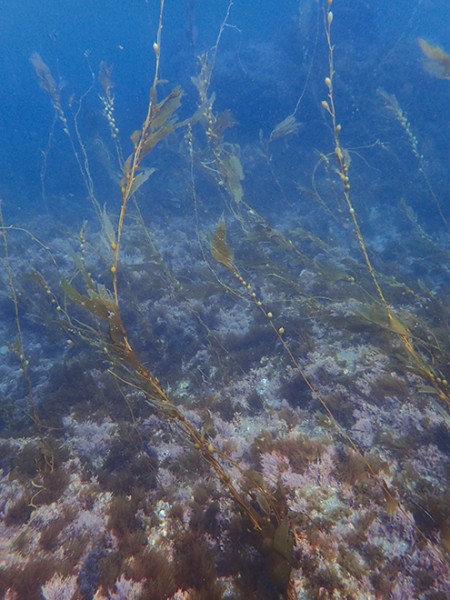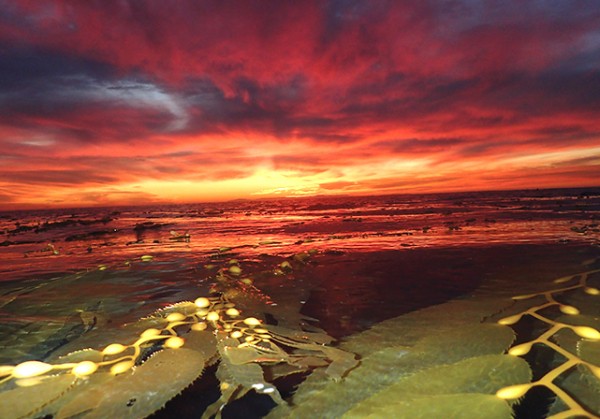
Warm water temperatures for nearly two years are starting to take a toll on the health of Laguna Beach’s offshore kelp forests, marine experts say.
El Nino conditions are bringing warm-water surface currents up from the coast of Mexico. The currents are transporting colorful and exotic fish usually seen in warmer, more southerly waters.
But for ocean animal and plant life that flourish in nutrient-rich cold water, warm water isn’t welcome. Warm ocean waters are devoid of nutrients that cold-water ocean fish and plants, like kelp, need to thrive, said Mike Curtis, a marine biologist who led the kelp reforestation here in 2002.
While some beds are holding their own, others, especially those in Laguna Beach, are losing their grip.
“The beds just aren’t there,” said Curtis, a consultant at Costa Mesa’s MBC Applied Environmental Sciences, which specializes in marine monitoring, ocean restoration and remediation cases.
Curtis and his team of scientists take aerial surveys quarterly that show the state of health of the kelp canopy, the top leaves of the kelp forest that float on the ocean’s surface. The canopy in south Laguna Beach is all but gone, according to their last survey in September. Kelp canopies in north Laguna, Corona del Mar and Newport Beach are still looking good, he said.
The difference, Curtis said, is water-temperature variations farther south and local topography. Coves, which number 32 in Laguna Beach, are usually shallower and hold warmer water, he explained. Upwelling, currents that come from colder depths, bring an abundance of nutrients, and kelp forests thrive.

Even though the kelp stalks and fronds, known as stipes and blades, are dwindling, the kelp holdfasts are holding their own, said marine biologist Nancy Caruso. Holdfasts are the kelp’s roots that wrap around rocks and reefs, fastening the plant in place.
“The kelp is still there,” she said. “It’s arrested due to the warm water. It’s not growing very tall, just a few feet, and it’s not at the surface.”
The water is cool enough 25 to 50 feet down, she said, for nutrients to still be available to the plant’s roots. Caruso volunteers for Reef Check California, a citizen-based data-collecting organization that last surveyed the kelp beds in October.
“This is a natural, normal El Nino,” she said. Kelp, which thrives in water temps between 43 and 57 degrees, is known as the fastest growing plant at one to two feet a day. Its fronds die off every few months.
Purple spiny sea urchins can wreak havoc on kelp, especially if there’s not enough to munch on and the urchins are hungry, said Caruso. This year, that’s not a problem, she said. The urchins started dying out earlier due to a “balding disease” and overpopulation has been curbed. “They’ve thinned out quite well,” said Caruso, who’s been monitoring local marine animal and plant life for 13 years.
The worst hit kelp beds are off the coast of San Onofre State Beach and Camp Pendleton, Curtis said. “There used to be a huge canopy of kelp there,” he said. “It’s gone.”
From Carlsbad State Beach down to Pt. Loma in San Diego, kelp beds are still thriving, according to the findings of the aerial survey.
The West Coast is usually exposed to the California ocean current, which travels from cold northern waters off of British Columbia and keeps cold upwelling from deeper waters. Kelp around the Channel Islands in Santa Barbara, Curtis said, still looks healthy but canopies drop off just above Malibu in Los Angeles, another hard-hit forest. “Beds from Malibu to Redondo are almost nonexistent,” he reported.
Considered one of the strongest El Ninos yet, warm water is expected to stay around for at least another six months, according to Eric Boldt, a meteorologist for the National Weather Service, a division of the National Oceanic and Atmospheric Administration.
“This is the year,” said Boldt, for wet weather and warm water. More canopies, said Curtis, will probably disappear.
Local snorkelers are also noticing the diminishing gold expanse of kelp forest cover. Sandy Dildine, who’s been diving in Laguna’s coves for 25 years, said she’s seeing kelp dramatically deteriorate over the last month.
“Most of the kelp is just bare stipes with no leaves,” she said. “I don’t think any of it makes it to the surface now, even at low tide.”
The thickest kelp bed she’s seen is near Deadman’s Reef, a diver’s haven on the north side of Crescent Bay. “But you can see there are also some bare stipes and the leaves are deteriorating,” she said.
In the El Ninos of 1997-98 and 2002 up to 2010, kelp was harvested off of Salt Creek in Dana Point and transplanted to Laguna Beach waters, Curtis said. In the 1984-85 El Nino, the kelp here survived and was used by Curtis and his team to restore forests off of Corona del Mar.
If the decline is severe, Curtis plans on replanting. It might be harder this time around, he said, because the Laguna Beach coastline is now protected under the Marine Protection Area law of 2012, which prohibits taking or adding anything to natural ocean habitats without special permits. “We’ll play it by ear,” Curtis said.
Whether the forests are still rooted and will return after the El Nino waters have passed is yet to be seen. When Curtis’s team replanted 25 acres of kelp forests along Laguna’s shores more than 10 years ago, it took 1,000 dives, he said. “I’m not going there yet,” he said.





[…] Laguna Beach Local News Kelp Forests Take a Hit from El Nino – Warm water temperatures for nearly two years are starting to take a toll on the health of Laguna Beach’s offshore kelp forests … a diver’s haven on the north side of Crescent Bay. “But you can see there are also … […]
[…] favorite underwater hangout in the world (which would make it my favorite hangout overall), disappeared. This made the waves a bit choppier and the fish a bit more sparse. Still, I was able to see the […]